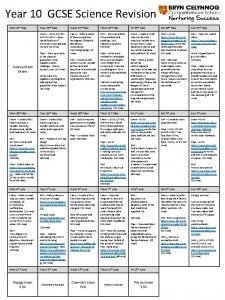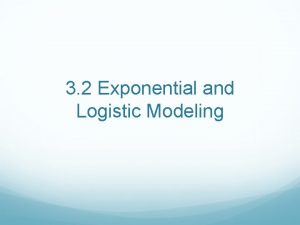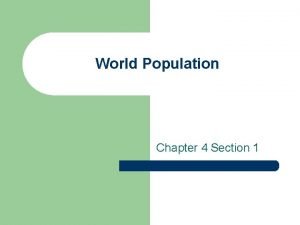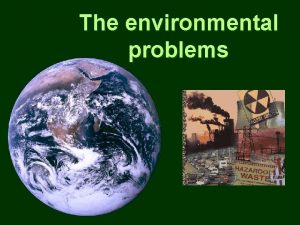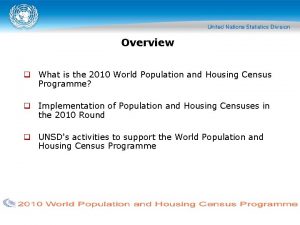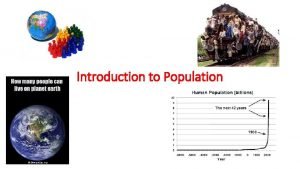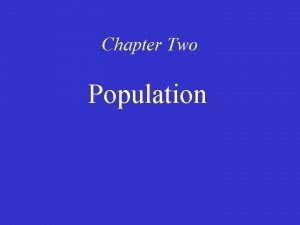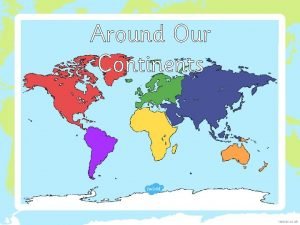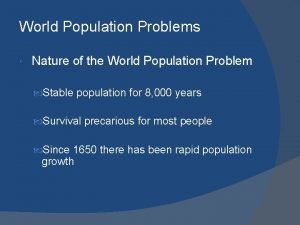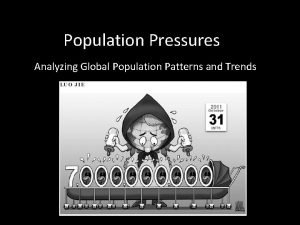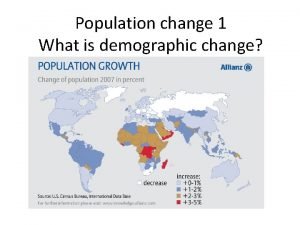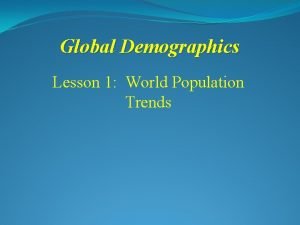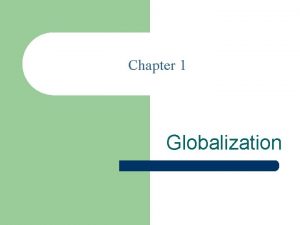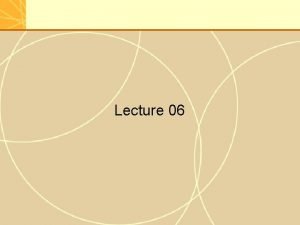Year 12 Revision Topic Population Specfication World Population



















































- Slides: 51

Year 12 - Revision Topic- Population

Specfication

World Population Growth- Causes • World Population has now reached 7 billion. Why? 1. Natural Increase (especially in LEDCs- where BRs remain high due to lack of awareness of contraception and children being able to work for additional income. ) 2. Better medical care and vaccinations against common diseases such as smallpox reducing DR. 3. Improvements in sanitation and food supply have also helped reduced the DR.

Past Paper Questions and Model Answers

2011 PPQ- Model Answer Explain why death rates started to fall from 1800 onwards? • Level 3 [5]–[6] An answer that refers to two factors that lower death rates • e. g. The idea of vaccinations had been discovered and so more babies were being inoculated against diseases like smallpox and didn’t die. • Also people were being educated about the need to use clean drinking water and proper sanitation was being installed in many cities, so diseases like cholera claimed fewer victims, again lowering the death rate.

2013 PPQ Model Answer Why are birth rates high in LEDCs? (3) • Level 3 e. g. This is probably due to high birth rates in many LEDC areas which still have to improve the standard of living for their people and thus ensure that families have access to appropriate birth control. [3] • Other appropriate answers include; high infant mortality rate, traditional larger families, children seen as economic assets etc.

2010 PPQ- Model Answer Reasons why the world’s population increased rapidly since 1950. • Level 3 ([5]–[6]) Candidates provide a full explanation covering two reasons • e. g. The death rate in many countries (MEDCs and LEDCs) has fallen dramatically as many of the diseases which commonly caused death such as smallpox was eradicated or controlled owing to improved medicine and sanitation. • Parents in LEDCs are still having large families because of a lack of awareness of contraception available therefore the birth rate remains high and the population continues to grow. [6]

Migration Case Study

Case Study- Migration UK You need to know: • to know how many migrate, • where from & where to • evaluate positive & negative impacts on services & economy • Remember – Evaluation question advantages, disadvantages AND CONCLUSION

How Many Migrate/ Where from and Where to: • UK population is growing because immigration is higher than emigration. • 574, 000 immigrated into the UK Where From? • Between 2004 -2008 700, 00 people from the A 8 countries came to the UK. • Many originated from Poland Where to in the UK? • Birmingham, London and Leeds have seen high influx of immigrants.

IMPACTS ON SERVICES ECONOMY £££ IMPACTS Positive: Increase in multicultural services. Increases awareness and diversity among people Negative: Pressure on education and health services. Class sizes and waiting times have increased. Increase need for housing- House prices in London up 10% Positive: 1999 -2000 contributed £ 31. 2 billion in taxes. Fill important skills gap in the UK labour market e. g. Nursing Negative: 1999 -2000 cost £ 28. 8 billion. Locals in competition for low paid jobs- resulting in job loss. Construction industry in the South of England Send home £ 10 million each day from UK

Population Pyramids

• A population pyramid details the population structure of a country. • It illustrates three age groups. Aged Dependency- 65 years + Economically Active Youth Dependency- 0 -14 years

Common Definition Question: Population Structure • Population structure is the way the population is ‘made-up’. • It is the age/sex structure of the population. • That is how many males or females there and how many make up the different age groups.

MEDC Population Pyramid Common Question- DESCRIBE- Make sure you Quote Wide Top = LDR Straight sides = low life expectancy Narrow Base = LBR

LEDC Population Pyramid Narrow Top= HDR Steep sides = Low Life Expectancy Wide Base = HBR

Out migration Missing young economically active in 20 s and 30 s age group. In migration Bulge in the economically active section

Assess the Economic and Social Implications of an Aged and Youth Population

MEDC- Aging Population Social (Statement- Consequence – Elaboration) • As people are living longer more people are now affected by degenerative diseases such as Alzheimer's. • This puts pressure on healthcare facilities and Nursing home provisions • Increasing waiting times and demands

MEDC- Aging Population Economic (Statement- Consequence – Elaboration) • People are claiming pensions for longer. • This may cause taxes to be increased. • Putting more pressure on the economically active to support this growing dependency group.

LEDC- Youthful Population Social (Statement- Consequence – Elaboration) • Many LEDC countries are affected by diseases such as AIDS. • Therefore parents may die young creating orphan children. • This increases the need for care facilities for young people.

LEDC- Youthful Population Economic (Statement- Consequence – Elaboration) • An increasing % of the population will be looking for employment. • Due to a lack of opportunities many will be forced to go into the informal sector. • This may result in life of crime- costing the government money.

Year 12 Revision Topic Settlement

Common small definition Questions Settlement a place where people live (1) Settlement Site The actual land a settlement is built on e. g. wet point site. (2) Types of settlement sites: Wet point site: • Site your settlement next to a water source • Good for cooking, cleaning, trading etc. Defensive site: • On top of a mountain • Settlement which could be easily defended from attacks. Bridging point site: • Narrowest point of a river as it is easy to cross here.

Settlement Hierarchy

Settlement Hierarchy- Key Terms Population Size: • Larger Settlements e. g. Belfast large population threshold • Smaller Settlements e. g. Kilkeel small population threshold. High and Low Order Goods: • Low order goods are items you buy every day e. g. milk They tend to be quite cheap • High order goods however are items that you buy rarely e. g. a new car They tend to be expensive Sphere of Influence or Range: • A large settlement tends to have a large sphere of Influence or range. This means people are willing to travel quite a distance to access services in this areas. E. G. A person from Enniskillen will happily travel to Belfast to shop for the day. • A small settlement tends to have a small sphere of influence or range. This means people are only willing to travel a short distance to access services in this area. E. G. A person from Belfast will not travel to Enniskillen to shop for the day. Function: • A settlement may hold a particular function E. G. Portstewart has a tourism function.

Bringing the terms together… Large Settlements: • Will have a high population threshold • And therefore can support both low and high order services • This means the area will have a larger sphere of influence or range and can attract many people. • It will also have multiple functions. Smaller settlements: • Will have low population thresholds • And therefore only provide low order goods or services. • Meaning a small sphere of influence or range which does not attract many people. • It will also have limited or no function.

GCSE Specification

CBD- Central Business District • Example- City Hall, Belfast Characteristics: 1. Tall Buildings value of land expensive, therefore developers build upwards to utilise space. 2. Commercial and retail Large office blocks and shopping centres. Most accessible and sought after part of the city. High rent! 3. No residential areas can not afford high rent charges. 4. Route Centre!

Inner City Characteristics: 1. Some buildings are old, dilapidated and boarded up, awaiting redevelopment. 2. Terraced Housing, small gardens (e. g. Holy Land’s) 3. Some high rise blocks of flats 4. Reduce travel costs- live near to workplacewalking distance.

Residential Suburbs • Semi detached houses built with gardens. • Bigger homes allowing families to grow. • Increase in car ownership and public transport fuelled the growth of this landuse.

Industrial Zone- Mallusk • Older industries were once located near the inner cities- therefore the city grew around them. • However more modern Industries are located on the outskirts. • Cheaper land more land space available. • Also nearby good communication links such as motorways, ports, railways etc

Rural Urban Fringe • Definition The area beyond the suburbs, that is, the area between the city and countryside where urban and rural is blurred • • • Larger housing with open space Detached Housing No pollution Lower valued land Higher transport costs- however more disposable income

Learning Intentions You must be able to: • Know and understand the causes of urbanisation. • Be able to refer to places in LEDCs and MEDCs for illustration purposes only • Explain how push and pull factors and natural increase cause urbanisation.

What is Urbanisation? An increase in the proportion of a country’s population who live in urban areas.

Counterurbanisation • Definition: The movement of people away from towns and cities to smaller towns, villages or areas in the countryside.

Causes of Urbanisation can result from two processes: • Push/Pull factors • Natural population increase

Push Factors People may be ‘pushed’ from the countryside for many reasons: • Mechanisation of agriculture reduces the need for labour in the countryside, leading to depopulation.

Pull Factors People may be ‘pulled’ towards the city for many reasons: • The re-location of many TNCs to LEDCs. Increasing the chance of getting a job. Factory work can pay up to 3 times as much as they could earn as a farmer. • Access to health care and education is much more possible in cities than in the countryside. This may improve their quality of life.

Natural Increase • Natural increase • When birth rates remain high while death rates may have fallen. • Higher Population living in the area.

Learning Intention You must be able to: • Describe and explain the growth, location and characteristics of shanty town areas, using one case study of an LEDC city. • Use place names and figures. • Shanty Towns in Kolkata, India


Learning Intentions You need to be able to: • Know case study details of one inner city urban planning scheme in an MEDC city. • Show the scheme aims to regenerate and improve the housing, employment and environment of the inner city. • Evaluate how sustainable the scheme is.

Background Knowledge: Past: • River Lagan- focus of trade and industry • H&W- 1800 s largest shipyard. • Area of wealth.

However… However over time: • Ships were no longer made here. • Ship building industry moved to Asia • Out- migration of people (no jobs) • River and surrounding land became derelict and polluted. • Unattractive to investment.

New Idea • Titanic Quarter Limited wanted to make this area an exciting waterfront development. • Decided to improve/regenerate the area. Focusing on housing, employment and environment

Housing: How did they improve housing? • To make the inner city a more attractive place to live they built 7500 new apartments. • This would be close walking distance to the city centre. • Attractive to young economically active. • There are now 5000 people who live and work in the Titanic Quarter.

Employment • Titanic Quarter is already home to over 100 companies • Currently has 4, 000 -plus employees- aims to have 50, 000 once the overall project is completed. • Firms such as Citigroup banking and Microsoft are located here. • Belfast Metropolitan Campus is also located here- training and developing local workforce. • Other industries such as Tourism is benefiting with local Restaurants, Hotels (Premier Inn) and Leisure Centres being established here.

Environment • As this scheme was regenerated upon a BROWNFIELD site this reduces the growth of the city. Protecting green spaces. • All industrial pollutants have also been removed restoring the environment of the area. • They also constructed a 1. 5 km of attractive water walkway which hosted the Tall Ships in 2009 • This means the area is now landscaped with open spaces improve biodiversity of local area.

Sustainability- Positive • Built on brownfield site reduced pressure on greenfield sites. • People now work and live in same area reduces congestion • Pedestrian walkways, bus and cycle routes Encourage people to not use cars highly accessible. • This also improved infrastructure as the Newtownards Road 2012 project. Which improved linkage between TQ and East Belfast. • Stepping stones project was established employment opportunities for unemployed people

Sustainability- Negative • TQ jobs could be occupied by well qualified people who live outside the city and therefore must commute to work. This therefore may increase congestion in the city. • Fewer jobs may actually be created than what they suggest. • Gentrification may have caused local people to no longer afford housing in their area. Forcing them to relocate elsewhere.
 Passive sentence
Passive sentence Year 7 spanish revision booklet
Year 7 spanish revision booklet Sats 2019 timetable
Sats 2019 timetable Year 7 science revision
Year 7 science revision French year 7 revision booklet
French year 7 revision booklet Year 10 science revision
Year 10 science revision Year 6 science revision
Year 6 science revision Year 9 maths revision booklet
Year 9 maths revision booklet Example of clincher sentence
Example of clincher sentence Research problem example for students
Research problem example for students How useful is this source
How useful is this source Year 6 poems
Year 6 poems The population of smallville in the year 1890 was 6250
The population of smallville in the year 1890 was 6250 Exponential functin
Exponential functin Population ecology section 1 population dynamics
Population ecology section 1 population dynamics Population ecology section 1 population dynamics answer key
Population ecology section 1 population dynamics answer key Population ecology section 1 population dynamics
Population ecology section 1 population dynamics Chapter 4 section 1 population dynamics answer key
Chapter 4 section 1 population dynamics answer key Go kiss the world summary
Go kiss the world summary World population clock
World population clock Guided reading activity 4-1 world population
Guided reading activity 4-1 world population Intj and istj
Intj and istj 1914 world population
1914 world population World's population
World's population 2010 world population
2010 world population Population
Population Cartogram world population
Cartogram world population World population by continent
World population by continent World population by age
World population by age Expansive constrictive and stationary
Expansive constrictive and stationary World population prospects
World population prospects World population
World population World population
World population Old vs new world monkeys
Old vs new world monkeys Coffee new world or old world
Coffee new world or old world Real world vs digital world
Real world vs digital world The world of forms
The world of forms Ap world history chapter 25 africa and the atlantic world
Ap world history chapter 25 africa and the atlantic world The changing world output and world trade picture
The changing world output and world trade picture History world tour
History world tour An elementary school classroom in a slum poem analysis
An elementary school classroom in a slum poem analysis This map becomes their window
This map becomes their window English world 1 unit 9
English world 1 unit 9 The changing world output and world trade picture
The changing world output and world trade picture Place value revision
Place value revision Active vs passive revision
Active vs passive revision Outwood english revision
Outwood english revision Gcse pe revision booklet
Gcse pe revision booklet Wjec criminology unit 4 past papers
Wjec criminology unit 4 past papers Criminology unit 4 crime and punishment
Criminology unit 4 crime and punishment Criminology unit 4 past papers
Criminology unit 4 past papers Wjec hospitality and catering revision
Wjec hospitality and catering revision





